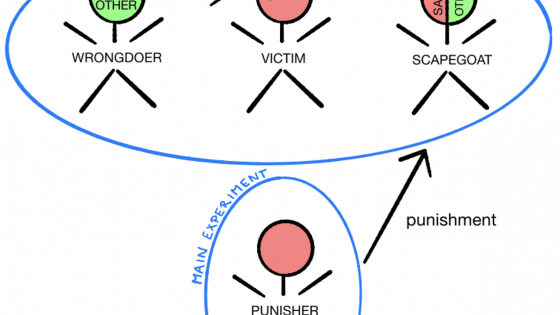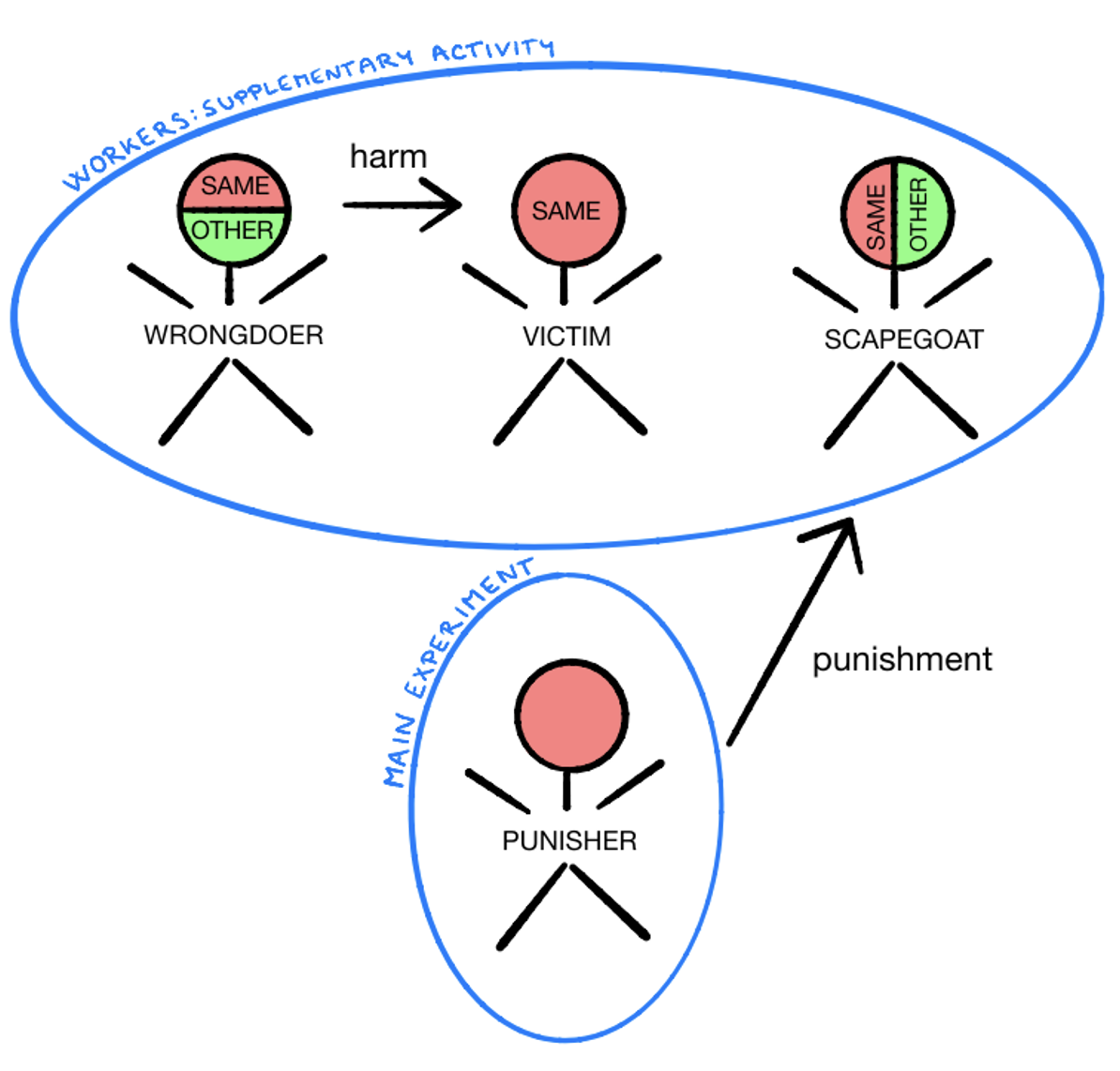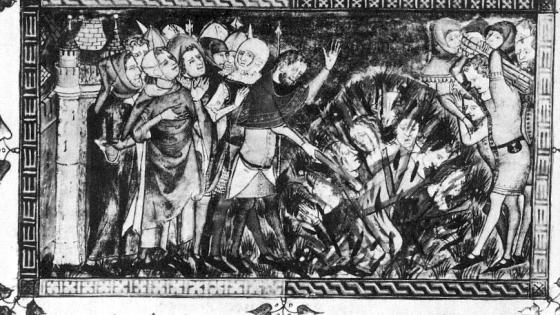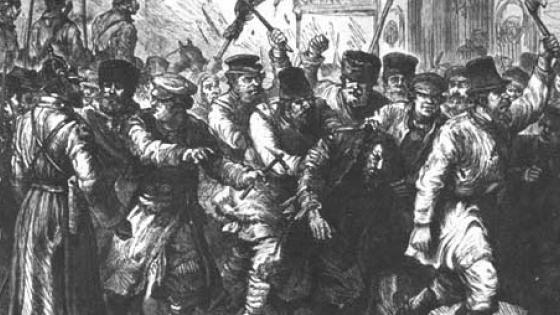Scapegoating refers to a social phenomenon whereby members of a majority group who feel frustrated or aggrieved take revenge on innocent people, usually members of vulnerable minority groups. According to social psychology, scapegoating occurs when the true source of anger goes unpunished, and people shift their aggression elsewhere (see, for example, the seminal work of Allport 1954). Scapegoating is thought to impel bursts of violence such as pogroms, lynchings, and even genocide. Evidence suggests that it can be triggered by crises like plagues, pandemics, or other disasters (e.g. Jedwab et al. 2020, Anderson et al. 2013, Grosfeld et al. 2019 for historical evidence and Daniele et al. 2020 for the effects of the covid pandemic). Scapegoating is not only a form of unfair violent behaviour; it may also drag minorities into conflicts completely unrelated to their conduct and transform individualised tensions into group conflicts.
Although anecdotal evidence abounds, cleanly identifying scapegoating behaviour with observational data is empirically challenging. First, it is nearly impossible to rule out the role of standard economic incentives for harming innocent individuals, such as the self-interested plundering of resources. In addition, most real-life situations contain an element of uncertainty about who originated the harm. Members of the dominant group may punish innocent individuals from minority groups because they attribute responsibility for misfortunes to actions of minority groups. A controlled experimental environment allows for the elimination of these confounding mechanisms. An experimental setup allows a researcher to:
- measure how people behave when punishment of wrongdoers is inhibited and people can punish only individuals who could not have causally contributed to the original harmful act,
- measure punishment responses in one-shot anonymous interactions that are costly for the punisher and provide no scope to materially benefit from punishment, and
- compare behaviour towards a weaker minority group and towards one’s own (majority) group.
For that purpose, we introduce a novel experimental paradigm, the Punishing the Scapegoat Game (Bauer et al. 2019). In this game, impartial spectators from the majority ethnic group can impose a monetary punishment on others at their own cost, after observing that someone malevolently destroyed the earned income of an individual from their own group. Existing incentivised experiments on the punishment of socially undesirable behaviour focus exclusively on the direct punishment of individuals who make active decisions about whether to violate a social norm, including the Third Party Punishment Game (Fehr and Fischbacher 2004, Bernhard et al. 2006). In contrast, a key element of the Punishing the Scapegoat Game is that we add a fourth person, the passive scapegoat who does not know the wrongdoer and is not involved in any way in the original wrongdoing. This feature allows us to separate the person who commits a harmful act from a person whom the impartial spectator can punish. We exogenously manipulate information about the ethnicity of the scapegoat to test whether people are more prone to redirect punishment onto members of minority groups if they cannot punish the wrongdoer.
Our experiment was set up between May and September 2017 in Eastern Slovakia, where there is a large Roma minority that has regularly suffered from discrimination. Taking part in our experiment were 337 young Slovak adults (aged 18–23) from the last two years of high school and a local university across two regions, and 484 young Roma adults from villages in the same two regions.
Figure 1 illustrates the Punishing the Scapegoat Game. A punisher is matched with three people: a wrongdoer, a victim, and a scapegoat. Specifically, on a tablet computer, the punisher observes three pictures: the first has 20 potential wrongdoers, the second has 20 potential victims, and the third has 20 potential scapegoats. Each picture displays 20 passport-style photos of people unknown to the punisher, homogenous in terms of ethnicity, and taken against a neutral background. The punisher knows that s/he is matched with one person from each set of 20 photographs, but does not know with whom specifically. The punisher is informed that each of these three people (wrongdoer, victim, and scapegoat) completed a work assignment and earned €8 for their work. Further, the punisher learns that after completing their work, the Wrongdoer had an option to reduce the earnings of the victim by €0, €2, €4, €6, or €8, and that the Scapegoat was utterly passive. Punishers learn that only the wrongdoer had the option to reduce the earnings of someone else, and only the victim’s earnings could have been reduced. The task of the punisher is to decide whether and by how much to reduce the scapegoat’s payment. Punishment is costly: reduction of each euro costs the punisher €0.10.
Figure 1 The Punishing the Scapegoat Game
The main result of our paper is displayed in Figure 2, showing the punishment of the scapegoat across the five specific amounts of the victim’s earnings that the wrongdoer could decide to destroy (€0, €2, €4, €6, and €8). The dashed line shows the average amount of euros that the punishers decided to destroy in the ‘same’ condition (when the scapegoat is also from the majority population), and the solid line shows the amount in the ‘other’ condition (when the scapegoat is a member of the Roma ethnic minority).
Figure 2 Punishment of the scapegoat by ethnicity
First, we see that the punishers are sensitive to the amount of harm done by the wrongdoer to the victim. The harm done to the scapegoat increases with the harm done by the wrongdoer. Second, almost no harm is done to the scapegoat when no harm is done by the wrongdoer. This is the case when subjects can harm a person from the majority Slovak group as well as from the Roma minority, suggesting that in ‘peaceful’ circumstances, people are not more inclined to harm the Roma.
Third, and perhaps most importantly, we show that scapegoating against members of the minority is triggered when the punisher has observed harm done by the wrongdoer. In situations in which the wrongdoer harmed the victim, we find a systematic difference in responses between the ‘scapegoat same’ and ‘scapegoat other’ conditions: punishment of scapegoats is twice as severe when the scapegoat is from the Roma minority than when the Scapegoat is from the majority population. Specifically, in ‘scapegoat same, an increase in harm intensity by one additional euro motivates punishers to lower the scapegoat’s earnings by an additional €0.08. In ‘scapegoat other’, the effect doubles to €0.16, and the difference between ‘same’ and ‘other’ is statistically significant, at the 1% level. Due to such magnified punishment of the ‘scapegoat other’, discrimination against the ethnic minority gradually rises with greater harm intensity and becomes statistically significant for situations when the wrongdoer destroyed €4, €6, or €8 of the victim’s earnings.
These results are robust to adding various controls, such as the subject’s observable characteristics, location fixed effects, parental education level, and experimenter fixed effects. Interestingly, the behaviour of the majority punishers is qualitatively the same, independent of gender, education status (secondary school or university), and parental education (proxying for socio-economic status).
By virtue of the experimental design, we are able to rule out statistical discrimination, over-attribution of responsibility, and differences in beliefs about future interactions between players as explanations for the results (see the paper for details). We can also rule out an explanation based on ‘collective punishment’, i.e. the scapegoat being punished because the wrongdoer is also from the Roma minority. We find that the scapegoat is not punished more when the wrongdoer is from the Roma minority than from the Slovak majority. Our design thus allows us to clearly identify scapegoating behaviour using the controlled environment of experiments. The observation of wrongdoing triggers latent discriminatory preferences against vulnerable minorities.
Our evidence of the scapegoating behaviour has several implications. First, it suggests that courts and other settings in which people make punishment choices are particularly scapegoating-prone environments, in line with evidence of strong biases against minorities in judicial decisions (Alesina and Ferrara 2014, Shayo and Zussman 2011). Second, the results suggest that ethnic minorities are at greater risk of facing aggressive behaviour when social problems within the dominant group become salient features of the social environment; thus, the protection of minorities need to be reinforced to rein in this type of behaviour. Third, we show that spikes in aggressive behaviour may not be driven by changes in economic incentives, which strengthens the case for taking seriously the behavioural channels, including scapegoating, through which deterioration of the social environment may fuel inter-group conflicts.
References
Alesina, A and E La Ferrara (2014), “A Test of Racial Bias in Capital Sentencing”, American Economic Review 104(11): 3397–3433.
Allport, G W (1954), The Nature of Prejudice, New York: Addison-Wesley.
Anderson, W, N Johnson and M Koyama (2020), “From the persecuting to the protective state? Jewish expulsions and weather shocks from 1100 to 1800”, VoxEU.org, 08 February.
Bernhard, H, U Fischbacher and E Fehr (2006), “Parochial Altruism in Humans”, Nature 442(7105): 912–915.
Bauer, M, J Cahlíková, J Chytilová, G Roland and T Želinský (2021), “Shifting Punishment on Minorities: Experimental Evidence of Scapegoating”, CEPR Discussion Paper 16453.
Daniele, G, A F M Martinangeli, F Passarellu, W Sas and L Windsteiger (2020), “Covid-19 and Socio-Political Attitudes in Europe: In competence we trust”, VoxEU.org, 01 October.
Fehr, E and U Fischbacher (2004), “Third-Party Punishment and Social Norms”, Evolution and Human Behavior 25(2): 63–87.
Grosfeld, I, S O Sakalli and E Zhuravskaya (2019), “Political and Economic Drivers of Pogroms”, VoxEU.org, 03 October.
Jedwab, R, N Johnson and M Koyama (2020), “Pandemics and the Persecution of Minorities”, VoxEU.org, 03 May.
Shayo, M and A Zussman (2011), “Judicial Ingroup Bias in the Shadow of Terrorism”, Quarterly Journal of Economics 126(3): 1447–84.










